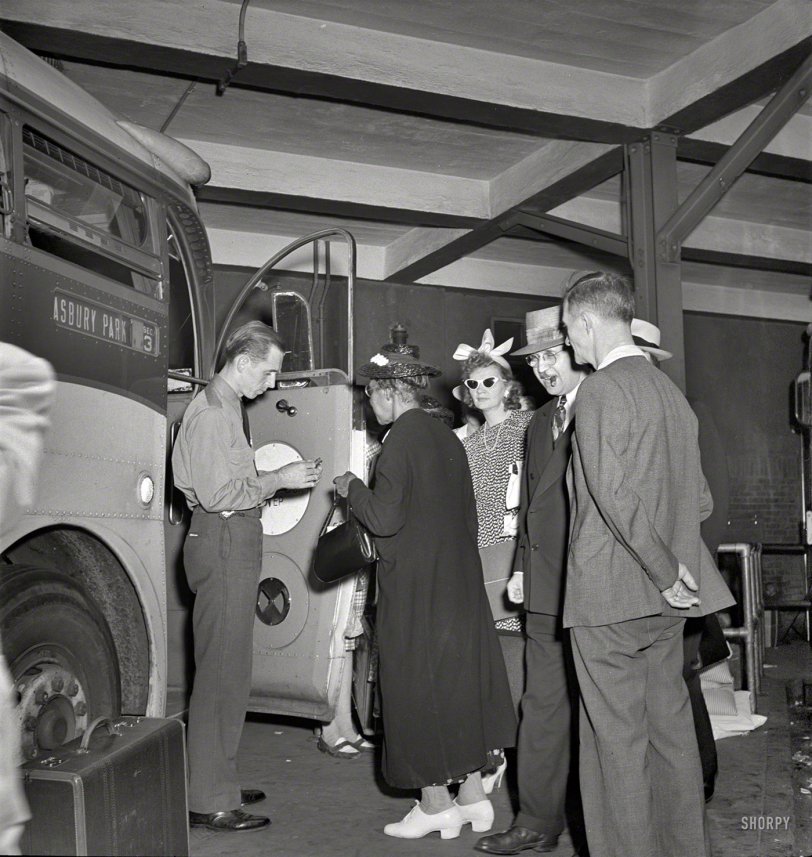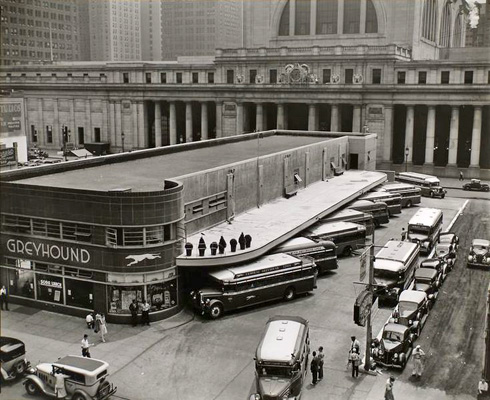


Framed or unframed, desk size to sofa size, printed by us in Arizona and Alabama since 2007. Explore now.
Shorpy is funded by you. Patreon contributors get an ad-free experience.
Learn more.

- Freeze Frame
- Texas Flyer wanted
- Just a Year Too Soon
- WWII -- Replacing men with women at the railroad crossing.
- Yes, Icing
- You kids drive me nuts!
- NOT An Easy Job
- I wonder
- Just add window boxes
- Icing Platform?
- Indiana Harbor Belt abides
- Freezing haze
- Corrections (for those who care)
- C&NW at Nelson
- Fallen Flags
- A dangerous job made worse
- Water Stop
- Passenger trains have right of way over freights?
- Coal
- Never ceases to amaze me.
- Still chuggin' (in model form)
- Great shot
- Westerly Breeze
- For the men, a trapeze
- Tickled
- Sense of loneliness ...
- 2 cents
- Charm City
- What an Outrage
- Brighton Park
Print Emporium
Incognito: 1942

September 1942. "New York, New York. Boarding interstate buses at the Greyhound terminal, 34th Street." En route to Asbury Park, safe from the paparazzi. Photo by Marjory Collins, Office of War Information. View full size.
Greyhound uniforms
Had this been a bit later, '50s-'60s, my aunt would have been able to claim she had had her hands in the driver's crotch! She loved saying that - her job at the uniform factory where all Greyhound uniforms were made was to do that fussy stitch at the bottom of the zipper.
Restricted
New York was not segregated, but many places like hotels and restaurants were "restricted". That is no Blacks or Jews allowed. This held true until the sixties, when things started to change.
Not certain -
- but the bus looks like a Yellow Coach 743.
Greyhound memories
I can remember many scenes like this from childhood while traveling with my grandmother in the late 1950s and early 1960s.
This driver is not wearing his uniform jacket, which was, like the pants, gray wool, and I seem to recall had blue piping and gold embroidered insignia, with a matching airline-style hat. It was very impressive to a child still in single digits. I thought they looked like a Confederate general.
The boarding queue was not segregated, everyone fell in line in no particular order, but, being below the Mason-Dixon line (South Carolina), after punching each African-American passenger's ticket, as the driver returned the receipt portion, he said, "Step to the rear of the bus, please." This all seemed very routine and matter-of-fact to me at the time. It was just the way things were done.
There were no on-board restrooms back then, and you had a clear view of the bench seat that extended across the very back end of the bus, and I remember one trip when I made up my mind that I wanted to ride back there. Both sections were really crowded. My grandmother kept whispering, "No, hush, you can't ride back there," and as I got louder and louder with my demands, everybody started giggling, especially the black passengers, at the little white boy who was being told he couldn't ride in the back of the bus. And I was pitching a tantrum over it.
Finally, an older black man, on that enticing back bench, said, "Let him come on back, it'll be all right, if the driver don't care." The driver didn't care, he was probably glad to get me pacified, so I ran down the aisle and they made room for me on that back seat. It didn't take long for me to realize that I couldn't see anything from there, and I went back up front.
34th Street Terminal
I found a photo of the old terminal, with Penn Station in the background, on Wikipedia. That block is now home to a large K-Mart and a Duane Reade, among other things. I know this because I stand there every morning on 34th and 8th, waiting for a private commute bus. The Bolt Bus picks up passengers one block down, between 8th and 9th.

History Lesson?
I was wondering if even in NYC, this African American lady was boarding first, if they were boarding from the back to the front. Was there segregation on Greyhound buses at that time in NYC?
Dressing up
It's remarkable to see how well dressed these people are to "hop the dog," as we used to call taking the Greyhound. These days people don't dress up even for a plane or ocean cruise.
The terminal
Manhattan's Greyhound terminal was a stylish Art Moderne structure directly across from Penn Station on Seventh Avenue. Built in 1935, it was gone within 30 years. Having been rendered largely superfluous by the opening of the enormous Port Authority Bus Terminal in 1950, it was demolished around the same time as the old Penn Station in the early 1960's.
























On Shorpy:
Today’s Top 5